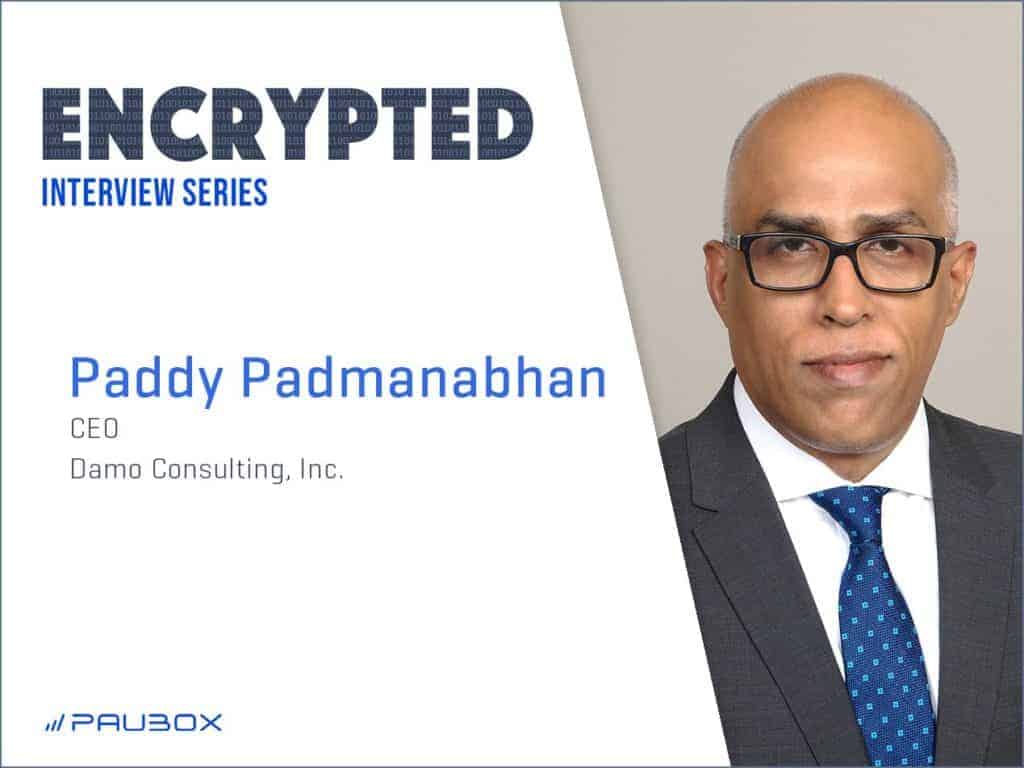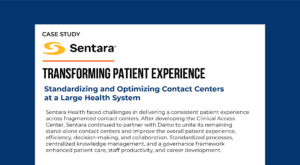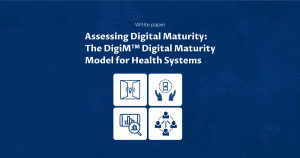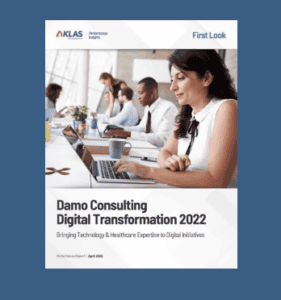An Interview with Paddy Padmanabhan: COVID-19’s Impact on Technology in Healthcare

The Paubox Encrypted Interview Series allows us to chat with leaders in healthcare IT, compliance and cybersecurity to pick their brains on trends and best practices.
In this Encrypted Interview, we chat with Paddy Padmanabhan, CEO of Damo Consulting, a digital transformation and growth advisory firm focused on the healthcare sector and author of The Big Unlock – Harnessing Data and Growing Digital Health Businesses in a Value-Based Care Era.
Early career and professional growth
Rick Kuwahara: So what is it about the healthcare sector, especially technology and innovation that has made you focus on it for such a large part of your career?
Paddy Padmanabhan: Good question. I got into it somewhat accidentally early on in the early 2000s. And I was in the financial services space prior to that.
I liked healthcare and I liked what I was doing. I liked healthcare tech and where it was going.
But the real turning point for me was when the HITECH Act and the Affordable Care Act went into law in 2009, thereabouts. So that was when the shoe dropped for me and it felt to me like healthcare was going to be transformed forever. And that it’s going to take a long time to undergo the transformation and it’s going to continue to evolve and grow.
It felt like a great opportunity and a place to be in. And I just stayed with it and haven’t regretted it since then.
Rick: Great. And so you started Damo Consulting in 2012. What drove you to the decision to start your own consulting firm versus joining another company?
Paddy: Yeah, I spent a long time in corporate America. My last corporate job was with Accenture, and I’d been a consultant for a long time.
I did a lot of work, very interesting work. But I always wanted to do something on my own.
So I left Accenture in 2012, and started Damo Consulting. But almost immediately, I got pulled into a Silicon Valley startup. And that startup was in the advanced analytics space. It was an AI startup before we started calling it AI, back then we called it predictive analytics. You know, long story short, we raised some venture capital and eventually were acquired by Salesforce.
I went on to found another startup, which was incubated within a private equity owned company, where I built an analytics platform. It was a population health management platform before we came up with the term population health management.
And that whole company, along with the incubator business, was sold to Harman International. I decided to step out of their entity and start focusing all my time on Damo Consulting.
Although I started the company in 2012. I effectively started running the business and building the business in the middle of 2014. So effectively, I’ve been doing this full time since 2014.
And why did we start this? Basically, I wanted to kind of create something on my own. I had worked for a corporate org for a really long time.
Enjoyed every bit of it, you know, had the growth and you know all the perks that come with it. A wonderful experience, met lots of smart people, all of that.
But it was time for me to move on and do something on my own. That’s how I really got into this.
Rick: So what’s been the biggest challenge or mission that you have at Damo Consulting.
Paddy: So our mission really is to create value at the intersection of healthcare and technology.
And I very strongly believe that technology is going to drive how healthcare is going to be experienced in the future. I want to be in a position to make an impact, in however small a way, as possible, by working with the people who are enabling the transformation using technologies, especially in emerging tech.
So that’s really my personal mission and for Damo Consulting and it’s kind of a corporate mission too.
In the end, it’s about improving the lives of patients, improving the experience for patients and improving healthcare outcomes for patients. We believe that technology is going to have a big part to play in it, and we want to make our mark and have an impact in some small way in how technology is used to change people’s lives through healthcare.
COVID-19’s impact on technology in healthcare
Rick: We’re seeing with the COVID-19 pandemic that is forcing a lot of providers to telehealth, and there is even the recent telehealth expansion notice that went out. Do you see this as kind of a turning point into the adoption of telehealth, and maybe even that opening up providers to being open to adopting other new technologies? Does that make sense?
Paddy: Absolutely. I think telehealth has been coming along nicely for the past few years, but it really wasn’t seeing the levels of adoption that one had hoped for.
And there were different reasons for it; the comfort level of physicians to use telehealth platforms to consult with their patients is one of them, and whether they’re trained for it, how do you really do a tele-visit as opposed to an in-person visit ? Etcetera, etcetera. So that’s one part of it, the aspect of delivering care through a virtual interface.
The other part, equally important part is that the reimbursement environment did not treat telehealth visits on par with in-person visits.
So the financial motivation was lacking. And I think you alluded to the recent clarification a few days back about telehealth visits being treated on par for reimbursements for Medicare patients anywhere, anytime.
So there’s actually three components to that announcement. So it’s not just synchronous telehealth visits, but it’s also virtual check-ins, which could be via phone for instance, and e-visits which could be asynchronous, and it’s still just an email interaction. So all of that is gonna get reimbursed.
And the important thing is that telehealth visits are gonna be reimbursed at the same rate as in-person visits.
That now takes away any financial disincentive, at a time when there is already a strong incentive to adopt telehealth. So I think the two are converging in a way that could constitute a tipping point for the future.
I’ve been talking to people and I’ve been following what’s going on through the media reports and so on. Clearly, there’s an uptick in telehealth visits. There’s a safety concern obviously that’s driving telehealth. But even for non-COVID related cases, now doctors are more comfortable doing telehealth visits.
So if it’s a routine check-in for some of the chronic condition, you don’t need to come into the the hospital because, firstly, they don’t want you to come in for whatever reason, and secondly, you now have the ability to take care of people in their homes for other conditions not related to COVID-19, and still get reimbursed.
So I think all of this is going to create a sort of a tipping point, and when we come out of this crisis, I think we’re gonna see a shift, a definite shift towards telehealth as a default mode of experience in care, at least for some aspects of care. That’s what I believe is gonna happen.
Rick: That’s great insights there. So you wrote The Big Unlock in 2017, which isn’t that long ago, but have you seen more movement in healthcare organizations utilizing data and embracing digital transformation?
Paddy: Yeah. People ask me this question all the time.
When I wrote this book in 2017, I made a set of predictions in the book about what was gonna happen in terms of the data, the emerging data sources and how data and analytics is going to drive digital transformation.
And most of what I was forecasting or predicted have come true. If anything, they’ve moved ahead even further than where I thought they would be.
So today we’re in a place where data is essentially driving healthcare decisions, and it’s an important enabler for healthcare decisions, because now you have the ability to aggregate large amounts of data from multiple sources and do it in a cost-effective way because you have a cloud infrastructure and so and so forth, well it doesn’t cost much. If anything, the costs are going down year-on-year.
And so now you have the ability to aggregate all of the data in one place, but more importantly, you now have a lot of advanced analytical tools, artificial intelligence, machine learning and so on, that can now detect patterns, make predictions and give you deeper insights than before, so you can now really make informed decisions about caring for your patients.
So the movement has definitely been in the direction that I thought it was gonna be. If anything, it’s getting even stronger. And as far as digital transformation is concerned, all the experiences that are now being re-imagined through digital tools and digital platforms, digital front doors and whatnot, all of that is driven in some way, shape or form by data and analytics at the back end.
And so, to that extent, we are seeing an acceleration. We just talked about telehealth, the shift towards telehealth which has been brought on by this crisis.
But I think we’re gonna see a lot of other experiences that are going virtual. And these virtual experiences are going to be driven by data analytics and superior interfaces.
An example of that is chatbots. So today, you can go online to any health system’s portal and you’ll… At least the larger leading health systems, you’ll find a tool there that enables you to self-triage your condition before you call in or reach out to a provider.
And those triaging tools are constantly learning through AI and machine learning algorithms. And it’s all powered by the data. So we’re seeing all of these converging in ways that I did not fully anticipate in 2017, but I could see it coming. If anything, it’s happening faster now.
Data privacy, security and innovation
Rick: That’s great. And that goes to another question that we had about a few of the articles that you’ve written, bringing up the point of data monetization in healthcare, as well as balancing that with patient access, and then also securing the data, of course.
So you mentioned how things are going a little bit faster than even you predicted. But with recent concerns, I know on Capitol Hill there’s the Data Privacy Act, the Senators wanting to question the Ascension and Google relationship. Is there a fear of data security possibly slowing down some of these advancements?
Paddy: I don’t believe it’s a question of slowing down as much as it is about really coming to an agreement on a set of principles around which the data is gonna be shared, accessed, and analyzed, and the analysis being made available.
My next book which is on digital transformation was supposed to come out in June, but it might get delayed a little bit. I’ve written it along with my co-author, Ed Marx, who’s the former CIO of the Cleveland Clinic. And we addressed this topic among others in the context of digital transformation.
We believe that the power of data to transform healthcare is something that we’re in the very early stages of harnessing. And yes, when private sector gets involved and big technology firms get involved, especially firms that are dealing with some kind of a reputational deficit, if you will, for things that they have done in other parts of their business, by using consumer data to target consumers in ways that people didn’t like or people didn’t approve or appreciate or whatever it is, those concerns somehow translate over into the healthcare arena.
And it becomes a little more sensitive simply because healthcare data is very, very personal, very, very sensitive and people don’t want other people looking at it because of the potential for abuse with the insights that come out of the data.
But I think, if we take a step back from all of the rhetoric that’s going on about the Google, Ascension deals and so on, and so forth, I don’t think anyone denies the fact that there is a lot of benefit to be gained by analyzing the data, gathering insights and using those insights to improve healthcare outcomes, I don’t think anyone denies it. I think it’s the manner in which these contracts are constructed, the access provisions that they have that need to be scrutinized. What happens to the data, where does it sit? Who gets to see it? Who gets the insights and what do they do with it? Those are questions that need to be dealt with, and I think the public needs to be given more confidence.
And I also believe that at a very practical level we need to get a common set of principles on the table and have everybody agree to it. It can’t be that every single data contract is different, and you as a patient, now that the final rules for interoperability are going into effect, you could be sharing your data with someone and if they don’t tell you how exactly they’re gonna use it, that’s not fair to you.
So I think there’s a lot of that that needs to be sorted through. And that’s why you’re, I think, seeing a lot of his rhetoric, in my view Rick.
Rick: Those are good points. And look forward to the book coming out, that’ll be great.
Paddy: Thank you.
Rick: Speaking of interoperability you wrote a few months ago, an article on why interoperability is cool again, and you kinda highlight the tension between at the time the proposed interoperability rules, the tension between healthcare organizations, tech firms, and the EHR vendors.
Paddy: Right.
Rick: Now that it’s going forward, what is your prediction on how this will all play out? And when do you think we’ll see the impacts of the implementation of the rules?
Paddy: So let me start by saying that, even before the rules went into effect, a lot of what people wanted to do through interoperability was already in flight. So it wasn’t as if people were not able to access data from electronic health record systems. The API economy is well under way.
And you can access data from electronic health record systems subject to certain constraints and governance and so on, and so forth. And the API-led strategy for unleashing innovation, unlocking insights is what I was mostly trying to refer to in the article about why interoperability is cool again.
Because APIs are really gonna be powering a lot of the innovation going forward, they help you to accelerate innovation and experiment at scale and fail fast, and all of the good stuff and really unlock the data, and more importantly allow application development to be practiced by a broader community, who don’t really have to go into the bowels of the technology to try and pull the data every single time they build an application.
So that’s what I was trying to refer to.
This is all in the backdrop of this ongoing tension that’s been going on for a while between big tech firms and digital health innovators who want access to the data sitting inside electronic health record systems.
And the CMS and the HHS, who have been promoting it, and who have been trying to get the EHR vendors on board and the EHR vendors for their part, at least one of them, one of the big ones that are saying that, “Hey, look, let’s just hit the pause button here because do we really know what we’re doing? We’re going to provide unrestricted access to patient data to the patients. Can they be trusted with the data?” Etcetera, etcetera.
In fact, I wrote a further piece after this, as well, where I talked about, you know what, “Hey, what are the questions here?”
Well, the questions are, can patients be trusted with the data? Can technology firms be trusted with the data? And so on and so forth. Well, all those questions I think have to be taken up one at a time.
And you’re not gonna have 100% smooth transition from where we are today to where we are going to be when patients actually get unrestricted access and can with the touch of a button to share it with anybody they like. Well, patients will find out too, what happens to their data.
I hope there isn’t a lot of serious unintended consequences, but there is some merit to being able to educate patients and make them aware that, “Hey, you have to be careful now that you have this access into the data.”
Well, there are other things that the final rule talks about, information blocking practices and penalties for blocking.
Those I think are separate from what I was talking about in the article, which was about why interoperability is cool again. I think, if anything now with the access is getting loosened up, if you’re in the integration API, kind of a space, I think… There’s a lot of good things ahead for you. That’s what I think.
Final Thoughts
Rick: How do you keep up with industry trends? Any good podcasts, blogs, influencers or newsletters that we should be following?
Paddy: I listen to several podcasts. That’s where I get a lot of my news and analysis. I read a number of publications, both tech and non-tech. And that’s kind of how I keep up to date on news.
And then you know, and then I do a lot of reading, both related to my field and outside of my field in order to get a broader perspective on what’s going on in the world out there.
What are the good podcasts? I listen to the HBR IdeaCast, which I think is a great podcast. I like that it features a lot of business leaders.
I mean, there are several podcasts out there. I think my friend Bill Russell has a good podcast, Health Lyrics. He has a lot of great, great guests.
There’s one from the Wall Street Journal that has a tech briefing every day that I listen to, which was kind of at a broader level. And you can figure out what’s going on in tech in general, across multiple sectors.
And blogs or influencers? There’s quite a lot of them out there. It’s hard to pick on any particular one.
But you know, CNBC’s Chrissy Farr does a good job of reporting on the healthcare tech sector. She focuses a lot on startups in particular, in the digital health ecosystem.
Healthcare newsletters that I read…I publish my own newsletter. It’s called the Healthcare Digital Transformation Leader, which is a highly curated set of articles and content. Two thirds of the content is outside content, articles written by others in other publications. About a third is our own content, including my column, like the article that we just talked about.
Rick: What do you do to de-stress and relax?
Paddy: Well, I’m a musician. I’ve been a musician for a really long time. I play guitar and I sing, and I’m in a band. I also do a solo acoustic show on weekends, in local bars and restaurants.
So that is completely different from what I do for a living. And in fact, I think it not just de-stresses me, I think it makes me better at my work because it opens up parts of my brain that I don’t use during my workweek.
And then you know, I spend time with the family. We travel a lot. And then I do as much outdoors as I can.
Given that I’m in Chicago, you know, during the winter months that gets to be a little hard. But you know, biking, hiking stuff like that. And I have two cats.














